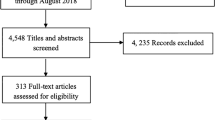Abstract
Purpose
To create a timetable for dating long bone fractures in infants aged less than 1 year using previously defined radiographic signs of fracture healing.
Materials and methods
A retrospective cross-sectional time series of long bone fractures in infants aged less than 1 year was conducted from 2006 to 2013. After exclusion criteria were applied 59 digital image series were available for review from 40 infants. Utilizing published criteria for dating fractures, the presence or absence of four pre-defined features of healing was scored: periosteal reaction, callus, bridging, and remodeling. Three radiologists independently scored radiographs with a 3-point scale, marking each feature as present, absent, or equivocal. The times in days when features were first seen, peaked (feature agreed present in >40% of images), and last seen were noted. Statistical analysis using free marginal kappa was conducted.
Results
The level of agreement among the three radiologists was high (0.64–0.85). The sequence in which the features were seen was: periosteal reaction range 7–130 (present in the majority of cases between 9 and 49 days); callus range 9–130 (present in the majority of cases between days 9–26); bridging range 15–130 (seen in the majority of cases between 15 and 67 days); remodeling range 51–247 days.
Conclusion
This study provides a timetable of radiological features of long bone healing among young infants for the first time. Dating of incomplete long bone fractures is challenging, beyond the presence of periosteal reaction, but a consistent sequence of changes is present in complete fractures.




Similar content being viewed by others
References
Skellern CY, Wood DO, Murphy A, Crawford M. Non-accidental fractures in infants: risk of further abuse. J Paediatr Child Health. 2000;36:590–2.
Hoskote A, Martin K, Hormbrey P, Burns E. Fractures in infants: one in four is non-accidental. Child Abuse Rev. 2003;12:384–91.
Malone CA, Sauer NJ, Fenton TW. A radiographic assessment of pediatric fracture healing and time since injury. J Forensic Sci. 2011;56:1123–30.
O’Connor JF, Cohen J. Dating fractures. In: Kleinman P, editor. Diagnostic imaging of child abuse. St. Louis: Mosby; 1998.
Walters MM, Forbes PW, Buonomo C, Kleinman PK. Healing patterns of clavicular birth injuries as a guide to fracture dating in cases of possible infant abuse. Pediatr Radiol. 2014;44:1224–9.
Kleinman P, Walters MM. Dating Fractures. In: Kleinman P, editor. Diagnostic Imaging of Child Abuse. UK: Cambridge University Press; 2015.
Prosser I, Maguire S, Harrison SK, Mann M, Sibert JR, Kemp AM. How old is this fracture? Radiologic dating of fractures in children: a systematic review. AJR Am J Roentgenol. 2005;184:1282–6.
Islam O, Soboleski D, Symons S, Davidson LK, Ashworth MA, Babyn P. Development and duration of radiographic signs of bone healing in children. AJR Am J Roentgenol. 2000;175:75–8.
Prosser I, Lawson Z, Evans A, Harrison S, Morris S, Maguire S, et al. A timetable for the radiologic features of fracture healing in young children. AJR Am J Roentgenol. 2012;198:1014–20.
Cumming WA. Neonatal skeletal fractures. Birth trauma or child abuse. J Assoc Can Radiol. 1979;30:30–3.
Yeo LI, Reed MH. Staging of healing of femoral fractures in children. Can Assoc Radiol J. 1994;45:16–9.
Halliday KE, Broderick NJ, Somers JM, Hawkes R. Dating fractures in infants. Clin Radiol. 2011;66:1049–54.
Acknowledgements
Elizabeth Caroll, Research Assistant.
Author information
Authors and Affiliations
Corresponding author
Ethics declarations
Conflict of interest
The authors declare that they have no conflict of interest.
Ethical approval
All procedures performed in studies involving human participants were in accordance with the ethical standards of the institutional and/or national research committee and with the 1964 Helsinki Declaration and its later amendments or comparable ethical standards.
Informed consent
This article does not contain identifiable patient data.
Appendix
Appendix
Rights and permissions
About this article
Cite this article
Warner, C., Maguire, S., Trefan, L. et al. A study of radiological features of healing in long bone fractures among infants less than a year. Skeletal Radiol 46, 333–341 (2017). https://doi.org/10.1007/s00256-016-2563-8
Received:
Revised:
Accepted:
Published:
Issue Date:
DOI: https://doi.org/10.1007/s00256-016-2563-8




